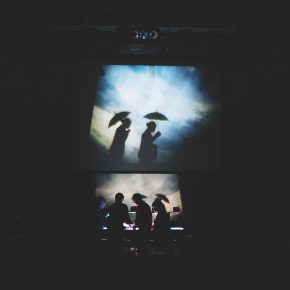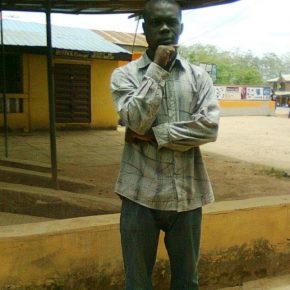ARDOR
A review by Christopher Bernard
Ava/Ada
Manual Cinema
Zellerbach Playhouse
March 16–18, 2018

Manual Cinema performs Ada/Ava Friday–Sunday, March 16–18, 2018 in the Zellerbach Playhouse. (Photo credit: Yi Zhao)
Chicago’s audacious theater company Manual Cinema has brought its hour of magic to Berkeley just past the ides of March this year, and if you have a theatrical bone in your body, you owe it to yourself to hie thee thither posthaste ere its pixie dust evaporates away into the memories of its enthusiasts.
The form Manual Cinema has created is as simple as it is imaginative: a hybrid of simple animation, Balinese shadow puppet play and live performance (including sound effects and music), using two screens and four overhead projectors, much like those many of us have all suffered through in high school classrooms and musty lecture halls, but with imagination and heart attached, like the balloon that haunts the show throughout.
The live performances make each performance unique and provide the same tension one feels watching a high-wire act: of course they won’t fall, but what if they do?
The story is of an admirable simplicity and originality: two ageing sisters, Ada and Ava—identical twins, as an array of old-fashioned oval-framed silhouettes adorning the walls of their home let us know in no uncertain terms—keep a lighthouse on a stormy coast, and one of them dies (no spoiler here, as the death occurs in the very opening).
The remaining sister has not only lost her oldest and closest companion, but in a sense has also lost her other self, and the rest of the story is what happens to her in her long journey to try to rejoin her sister, through memories of their growing up together, dream and nightmare, an unfinished chess game, and the haunting presence of a tall pier mirror that taunts the surviving sister with the image of her dead twin, which is, of course, her own.
We are told the story in a series of acetate and paper projections, thrown against a small screen at the back of the stage, as the performers work the models in full view of the audience onstage, with their backs to us.
The performers portraying the two sisters act out their scenes in front of that first screen. The shadows on the screen are then thrown onto a considerably larger one hanging high above the stage, and in mirror-reverse from the action seen on the first. That second screen, combining the projected images into one commanding image is what rivets the audience’s attention from first to last, though one can, at any moment, glance down to watch the “kitchen” where the febrile stew is being concocted.
The strongly convincing performers included Vanessa Valliere as Ada and Kara Davidson as Ava, as well as puppeteers Dru Dir (who directed and first explored the ideas that eventuated in the show), Sam Deutsch and Charlotte Long. The musicians, whose music subtly shaped the show’s emotional cast, were Michael Hilger, Kyle Verger and Quinn Tsan, who also performed the colorful and clever sound effects.
One thing about the names: one might be forgiven for thinking of the heroine of Vladimir Nabokov’s longest novel for “Ada,” or Ava Gardner for her twin. One might also think of “avian” for Ava, as in at least one scene, a bird appears above Ava’s grave. And of course, there are only two letters to add or change to go from either Ava or Ada to “alma,” the soul.
The show’s only weakness is its conclusion, where the authors are clearly unable to figure out how to end their story. The story’s logic sternly leads in one direction only, but they can’t quite muster the courage to go there, and so equivocate, sweetly enough if not entirely convincingly. But forgivably.
To say too much would be to spoil a show of such fine delicacy of spirit and subtle strength. Leave it at this: stormy nights and threatening seas, beautiful dreams and fearful nightmares, gaiety and deviltry, mischievous teapots and nagging clocks (one of them advertising the “Menaechmi Bros.”—from the Roman Plautus’s comedy about twins), fights between the sisters and a near drowning, a visit to a carnival and a visit to the regions of death, chess games and halls of mirrors, a lost balloon and a forever kept shell, skeletons and graveyards and spiral staircases, and the looming light of the lighthouse, twisting like an owl’s eye and forever threatening to go out for good, and the mystery of who one is, and the mystery of death, and the mystery of reconciling ourselves to the mysteries of life.
_____
Christopher Bernard is co-editor of the webzine Caveat Lector. His novel Voyage to a Phantom City came out in 2016; his second collection of poetry, Chien Lunatique, came out in 2017. His new novel (currently being serialized in Synchronized Chaos) will appear later this year.




